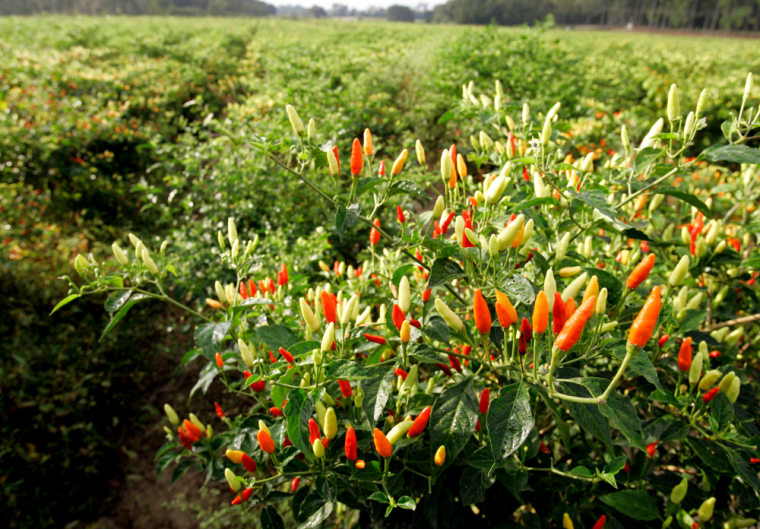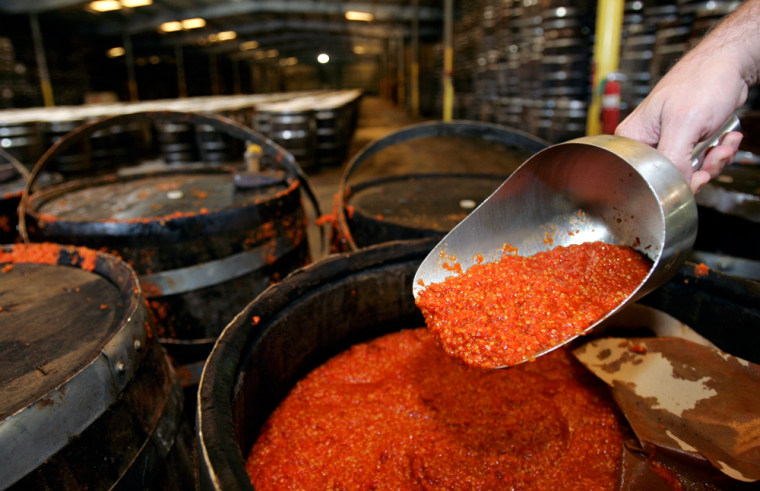Not long after you cross the little bridge leading over Bayou Petite Anse — "Little Cove'" in the Cajun French spoken in these parts — whiffs of the spicy fragrance of Tabasco pepper drift through the air.
Stand next to the factory where they pump out the hot sauce at the rate of 600,000 bottles a day, and the powerful essence is enough to make your eyes water and start you coughing.
E.A. McIlhenny invented the blend of peppers, salt and vinegar here after the Civil War, and everything on 2,200-acre Avery Island, from the bayou bridge on, belongs to his descendants. Visitors can tour the factory where the family still produces the famous condiment, which now generates $250 million in annual revenue, according to the just released book, "McIlhenny's Gold: How a Louisiana Family Built the Tabasco Empire."
But there's another tourist draw here in addition to the Tabasco factory — a 250-acre wildlife refuge called Jungle Gardens that is also part of the McIlhenny family legacy.
Filled with a multitude of plants, flowers and trees, Jungle Gardens offers a wilder adventure than most botanical gardens. Visitors can ride through woods, meadow, swamp and bayous. But guests are encouraged to get out of their cars and spend time wandering among the ancient trees, draped with Spanish moss. It's a better way to appreciate the beauty of the place, and more adventurous than driving.
Rabbits freeze in fields, egrets and huge blue herons stalk fish along streams and ponds, deer nibble grass, giant turkey vultures perch in trees, all sizes of turtles sun themselves.
And there are the alligators. From tiny to adults of four feet or more, they line most of the bayous or hover just below the water's surface, only nose and eyes visible.

"Things here are still a little on the wild side," said Harold Osborn, a fifth-generation member of the family who now oversees the agricultural work on the island. "It's a little edgy, not a place with every stone in place, everything planned out."
Signs warn visitors to stay away from the alligators, which will hiss when approached and have been known to move menacingly toward people who invade their territory. Most people heed the warnings, Osborn said, although he has seen some holding toddlers out toward the gators to give them a better view.
"We haven't had many problems with injuries," Osborn said. "We had a boy break an arm. He had climbed a tree and fell out. And an alligator got a little dog some people had let out to run."
Jungle Gardens not only showcases native plants, it is now home to varieties of azaleas, camellias and bamboo and other exotic plants that draw both experts and fans from around the world.
In the spring the pond called "Bird City" is covered with the nests of snowy egrets. The birds were once hunted for their feathers, and E.A. McIlhenny is credited with helping to save them from extinction by establishing and protecting a colony here for them.
The term island is a misnomer for Avery; it's located three miles inland from Vermilion Bay, which opens onto the Gulf of Mexico. The "island" is just a hump of land formed by a salt dome. The dome, one of five in the area pushed up by huge salt deposits, rises about 163 feet above the flat Southwest Louisiana landscape. Indians once harvested the mineral here, and salt used in the sauce still comes from the salt mine.
The Tabasco factory tour begins with an 11-minute film on the history of the sauce. That's followed with a guided walk past large windows that allow a view of the factory bottling process and into an area of interactive displays ranging from Tabasco in the movies, to the geology of the island.
The tour is designed to end at the Tabasco Country Store where you can buy everything from clothing to Tabasco-flavored Spam. Go ahead and try the Tabasco ice cream — it's delicious.
